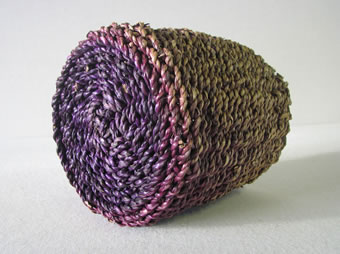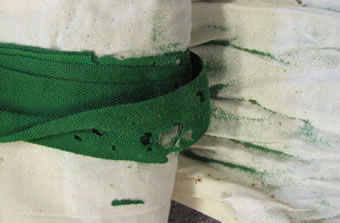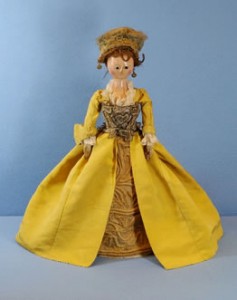Social history - behind the scenes
Many of the objects in our collection, such as costume and textiles, are fragile and need help to survive. We try to protect them from risks such as light, fluctuating temperature and humidity, and insect damage.
Light damage
Too much light, particularly sunlight, can damage textiles. Light can also weaken textile fibres, change the colour of wax, and even make plastics yellow and brittle. This is why we keep light levels low in our galleries.
The basket pictured, from the home of a member of staff, shows how damaging light can be.
The bright purple dye, used to colour the basket, has faded in places, resulting in almost total colour loss. Some of the purple can still be seen on the base, where it was hidden from the light.

Insect attack
A large banner, c.1850 to 1900, was recently re-packed by museum staff. On unwrapping the banner it was discovered that the straps used to tie and hang it had been eaten by insects.

Holes had been made in the woollen fabric, and there was evidence of small green grains called ‘frass’. Frass is the name for insect droppings and is often the colour of the fabric being eaten. The insects were identified as carpet beetle.
Carpet beetle feed on fur, feathers, wool and other textile fabrics. Their larvae are short, fat and hairy and are often called ‘woolly bears’. As the larvae feed and grow they shed their skin and these are often the first sign of an infestation.
Many of our 19th century dolls have fabric or leather bodies. These are filled with materials such as straw, sawdust and human hair – a feast for insects like moth and carpet beetle.
When we moved some of our objects from the Doll Museum at Oken’s House, we were able to clean them and treat them for potential insect infestation.
Conservation of a doll

Some of the dolls and toys in our collection require conservation treatment to stabilise their condition. This can take a variety of forms. Textile conservator, Victoria Allan, recently worked with this 18th century ‘Queen Anne’ doll.
She is wearing a yellow silk dress in a style known as an ‘open robe’. This means that the dress is open at the front to reveal the quilted skirt or petticoat underneath. We think these garments were made at the same time as the doll, in the 1780s. Other parts of the doll’s dress are probably not original, like the lace bodice.




